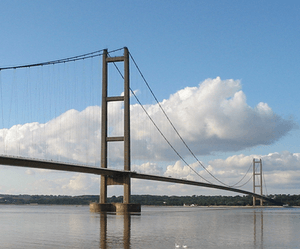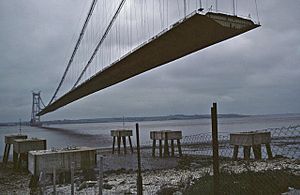Humber Bridge facts for kids
Quick facts for kids Humber Bridge |
|
|---|---|

The Humber Bridge, Lincolnshire/East Yorkshire
|
|
| Coordinates | 53°42′23″N 0°27′01″W / 53.7064°N 0.4502°W |
| Carries | 4 lanes of motor traffic (A15), pedestrian- cycle-way either side |
| Crosses | Humber |
| Locale | Hessle, East Riding of Yorkshire/North Lincolnshire |
| Maintained by | The Humber Bridge Board |
| Heritage status | Grade I listed |
| Characteristics | |
| Design | Suspension |
| Total length | 2,220 m (7,280 ft; 1.38 mi) |
| Width | 28.5 m (94 ft) |
| Height | 155.5 m (510 ft) |
| Longest span | 1,410 m (4,630 ft; 0.88 mi) |
| History | |
| Construction cost | £98,000,000 £151,000,000 including interest at completion |
| Opened | To traffic on 24 June 1981 Officially on 17 July 1981 |
| Statistics | |
| Daily traffic | 120,000 vehicles per week |
| Toll |
Toll/Humbertag discount
|
| Lua error in Module:Location_map at line 420: attempt to index field 'wikibase' (a nil value). | |
The Humber Bridge is a very long suspension bridge in England. It connects the areas of East Riding of Yorkshire and North Lincolnshire by crossing the River Humber. The bridge opened to traffic on 24 June 1981.
When it first opened, the Humber Bridge was the longest single-span suspension bridge in the world! It held this record for 17 years. In 1998, the Akashi Kaikyō Bridge in Japan became longer. Today, the Humber Bridge is the eleventh-longest suspension bridge of its kind. It is still the longest one you can walk or cycle across.
The bridge connects Barton-upon-Humber on the south side with Hessle on the north side. You can see the bridge from many miles away. It is also a special Grade I listed building, which means it's very important and protected. By 2006, about 120,000 vehicles crossed the bridge every week.
Contents
Building the Humber Bridge
Why Was the Bridge Needed?
Before the Humber Bridge was built, people had to cross the Humber by ferry boat. If they wanted to drive, they had to go a very long way around. This meant driving on smaller roads that were often busy and foggy. The journey was slow and sometimes dangerous.
People had been talking about building a bridge for a long time. Plans were first made in the 1930s and again in 1955. But it was hard to get enough money for such a big project.
How the Bridge Project Started
Work on the bridge finally began on 27 July 1972. The idea for the bridge was approved by a special law called the Humber Bridge Act in 1959. This law created the Humber Bridge Board. Their job was to manage the project and find the money to build the bridge.
Getting the money was difficult until 1966. At that time, the Prime Minister, Harold Wilson, needed to win a special election. To help, his Minister of Transport, Barbara Castle, agreed to let the bridge be built. This decision helped the project move forward.
Who Designed the Bridge?
The main engineers for the Humber Bridge were from a company called Freeman Fox & Partners. Sir Ralph Freeman first thought of the idea in 1927. Later, in 1964, an engineer named Bernard Wex designed the bridge that was actually built. The bridge was designed to last for 120 years!
Scientists even used a wind tunnel to test the bridge's design. This helped them make sure the bridge could handle very strong winds, up to 105 miles per hour.
How the Bridge Was Built
Building the Humber Bridge was a huge job! The main parts of the bridge were made by British Bridge Builders. The concrete towers and foundations were built by John Howard & Co Ltd. Concrete was chosen for the towers because it was cheaper and looked good in the landscape.
Work on the foundations started in March 1973. The towers were built using a method called slipforming. The north tower was finished by May 1974. The south tower was completed by September 1976. The bridge was originally planned to open in 1976, but it took a bit longer.
One of the most important parts was spinning the main cables. This happened between September 1977 and July 1979. Each cable is incredibly strong and weighs about 5,500 tonnes. The road deck itself is made of large box girder sections, each weighing around 140 tonnes.
The bridge officially opened to traffic on 24 June 1981. Queen Elizabeth II formally opened it on 17 July 1981.
Bridge Records and Benefits
With its long main span of 1,410 meters (4,626 feet), the Humber Bridge was the longest single-span suspension bridge in the world for 17 years. It held this record until the Akashi Kaikyō Bridge opened in Japan in 1998. However, the Humber Bridge is still the longest of its kind that you can cross by walking or cycling.
The bridge made travel much easier for people in the area. For example, the driving distance between Hull and Grimsby was cut by almost 50 miles! This helped reduce traffic in other towns too.
Humber Bridge Facts and Figures
The bridge has a dual carriageway for cars and trucks. It also has paths on both sides for people to walk or cycle. There's a speed limit of 50 miles per hour on the bridge.
Each of the bridge's towers is 155.5 meters (510 feet) tall. They are made of hollow concrete columns. The bridge is designed to move and bend. It can move more than 3 meters (10 feet) in strong winds of 80 miles per hour!
Interestingly, the towers are 36 millimeters (1.4 inches) farther apart at the top than at the bottom. This is because of the curve of the Earth! The total length of the suspension cables is an amazing 71,000 kilometers (44,117 miles).
The north tower is built on solid ground, but the south tower is in the water. Its foundations go down 36 meters (118 feet) because of the shifting sand in the estuary.
Paying to Cross the Bridge
Toll System Updates
In July 2013, work began to update the bridge's toll system. The old system was from 1981 and needed to be replaced. The new electronic system helps reduce waiting times for drivers.
Since 2015, people can set up an account with the bridge. They can get a small electronic device called a HumberTAG. This tag lets the system recognize the user, and the toll is taken from their account automatically. There are even special lanes where account holders can drive through without stopping.
Bridge Tolls and Debt
When the bridge first opened, there was a charge, or "toll," to cross it. This money helps pay for the bridge's upkeep and its original building costs. In 2012, the toll for cars was £1.50. Before that, it was £3.00, making it one of the most expensive toll crossings in the UK at the time.
Over the years, there have been discussions and protests about the toll charges. People felt the tolls were too high. In 2007, a protest was held, supported by local groups and politicians. They wanted to make it easier for people, especially those going for medical treatment, to cross without paying.
In 2008, local newspapers launched a campaign called "A Toll Too Far." They wanted to reduce or even get rid of the toll. Thousands of people supported this campaign.
In 2011, the toll was raised again, making it the most expensive in the UK at that time. However, in November 2011, the government announced good news! They agreed to reduce the bridge's debt by £150 million. This allowed the toll for cars to be cut in half, to £1.50, starting in April 2012. This was a big help for people who use the bridge regularly.
Image gallery
See also
 In Spanish: Puente del Humber para niños
In Spanish: Puente del Humber para niños










